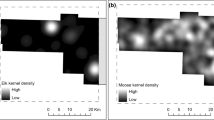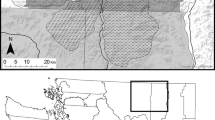Abstract
We examined chase distances of gray wolves Canis lupus Linnaeus, 1758 hunting moose Alces alces and roe deer Capreolus capreolus, and recorded details of encounters between wolves and prey on the Scandinavian Peninsula, 1997–2003. In total, 252 wolf attacks on moose and 64 attacks on roe deer were registered during 4200 km of snow tracking in 28 wolf territories. Average chase distances were 76 m for moose and 237 m for roe deer, a difference likely due to variation in body size and vigilance between prey species. A model including prey species, outcome of the attack, and snow depth explained 15–19% of the variation found in chase distances, with shorter chase distances associated with greater snow depth and with successful attacks on moose but not on roe deer. Wolf hunting success did not differ between prey species (moose 43%, roe deer 47%) but in 11% of the wolf attacks on moose at least one moose was injured but not killed, whereas no injured roe deer survived. Compared with most North American wolf studies chase distances were shorter, hunting success was greater, and fewer moose made a stand when attacked by wolves in our study. Differences in wolf encounters with moose and roe deer likely result from different anti-predator behaviour and predator-prey history between prey species.
Similar content being viewed by others
References
Adams L. G. and Dale B. W. 1998. Timing and synchrony of parturition in Alaskan caribou. Journal of Mammalogy 79: 287–294.
Berger J. 1978. Group size, foraging, and antipredator ploys: an analysis of bighorn sheep decisions. Behaviour Ecology and Sociobiology 4: 91–99.
Berger J. 1999. Anthropogenic extinction of top carnivores and interspecific animal behavior: implications of the rapid decoupling of a web involving wolves, bears, moose and ravens. Proceedings Royal Society, London B. 266: 2261–2267.
Boyce M. S., Mao J. S., Merrill E. H., Fortin D., Turner M. G., Fryxell J. and P. Turchin 2003. Scale and heterogeneity in habitat selection by elk in Yellowstone National Park. Ecoscience 10: 421–431.
Cederlund G. and Liberg O. 1995. [The roe deer — the animal, ecology and hunting]. Almqvist and Wiksell Tryckeri, Uppsala: 1–300. [In Swedish]
Crisler L. 1956. Observations of wolves hunting caribou. Journal of Mammalogy 37: 337–346.
Dussault C. Ouellet J. P., Courtois R. Huot J., Breton L. and Jolicoeur H. 2005. Linking moose habitat selection to limiting factors. Ecography 28: 619–628.
Estes R. D. 1966. Behavior and life history of the wildebeest (Connochaetes taurinus Burcell). Nature 5066: 999–1000.
Fryxell J. M., Greever J. and Sinclair A. R. E. 1988. Why are migratory ungulates so abundant? American Naturalist 131: 781–798.
Fryxell J. M. and Sinclair A. R. E. 1988. Causes and consequences of migration by large herbivores. Trends in Ecology and Evolution 3: 237–241.
Gipson P. S., Ballard W. B., Nowak R. M. and Mech L. D. 2000. Accuracy and precision of estimating age of gray wolves by tooth wear. The Journal of Wildlife Management 64: 752–758.
Haglund B. 1968. Winter habits of large carnivores. Viltrevy 5: 213–361. [In Swedish with English summary]
Hamilton W. D. 1971. Geometry for a selfish herd. Journal of Theoretical Biology 31: 295–311.
Hayes R. D. and Harestad A. A. 2000. Wolf functional response and regulation of moose in the Yukon. Canadian Journal of Zoology 78: 60–66.
Hebblewhite M. and Pletscher D. 2002. Effects of elk group size on predation by wolves. Canadian Journal of Zoology 80: 800–809.
Hebblewhite M., Merill E. H. and McDonald T. L. 2005. Spatial decomposition of predation risk using resource selection functions: an example in a wolf-elk predator-prey system. Oikos 111: 101–111.
Huggard D. J. 1993. Effect of snow depth on predation and scavenging by gray wolves. The Journal of Wildlife Management 57: 382–388.
Hunter L. T. B. and Skinner J. D. 1998. Vigilance behavior in African ungulates: the role of predation pressure. Behavior 135: 195–211.
Jędrzejewski W., Jędrzejewska B., Okarma H., and Ruprecht A. L. 1992. Wolf predation and snow cover as mortality factors in the ungulate community of the Białowieża National Park, Poland. Oecologia 90: 27–36.
Jędrzejewski W., Jędrzejewska B., Okarma H., Schmidt K., Zub K. and Musiani M. 2000. Prey selection and predation by wolves in Białowieża Primeval Forest, Poland. Journal of Mammalogy 81: 197–212.
Jędrzejewski W., Schmidt K., Theuerkauf J., Jędrzejewska B., Selva N., Zub K. and Szymura L. 2002. Kill rates and predation by wolves on ungulate populations in Białowieża Primeval Forest (Poland). Ecology 83: 1341–1356.
Kaufmann M. J., Varley N., Smith D. W., Stahler D. R., MacNulty D. R. and Boyce M. S. 2007. Landscape heterogeneity shapes predation in a newly restored predator-prey system. Ecology Letters 10: 690–700.
Kleiman D. G. and Eisenberg J. F. 1973. Comparisions of canid and felid social systems from an evolutionary perspective. Animal Behaviour 21: 637–659.
Kolenosky G. B. 1972. Wolf predation on wintering deer in east-central Ontario. The Journal of Wildlife Management 36: 357–369.
Kruuk H. 1972. The spotted hyena. University of Chicago Press, Chicago: 1–368.
Kruuk H. and Turner M. 1967. Comparative notes on predation by lions, leopard, cheetah, and wild dogs in the Serengeti area, East Africa. Mammalia 31: 1–27.
Kunkel K. E. and Pletscher D. H. 2000. Habitat factors affecting vulnerability of moose to predation by wolves in south-eastern British Columbia. Canadian Journal of Zoology 78: 150–157.
Lavsund S. and Sandegren F. 1989. Swedish moose management and harvest during the period 1964–1989. Alces 25: 58–62.
Liberg O. 1998. [The lynx — the animal, ecology and humans]. Almqvist and Wiksell Tryckeri, Uppsala: 1–95. [In Swedish]
Liberg O., Cederlund G. and Kjellander P. 1994. Population dynamics of roe deer (Capreolus capreolus) in Sweden: a brief review of past and present. [In: Proceedings of the third international congress on the biology of deer, Edinburgh. J. A. Milne, ed]. Macaulay Land Use Research Institute, Aberdeen: 96–106.
Liberg O., Andrèn H., Pedersen H.C., Sand H., Sejberg D., Wabakken P., Åkesson M. and Bensch S. 2005. Severe inbreeding depression in a wild wolf Canis lupus population. Biology Letters 1: 17–20.
Lima S. L. and Dill L. M. 1990. Behavioral decisions made under the risk of predation — a review and prospectus. Canadian Journal of Zoology 68: 619–640.
Lingle S. and Pellis S. M. 2002. Fight or flight? Antipredator behavior and the escalation of coyote encounters with deer. Oecologia 131: 154–164.
MacNulty D. R., Mech L. D. and Smith D. W. 2007. A proposed ethogram of large-carnivore predatory behaviour, exemplified by the wolf. Journal of Mammalogy 88: 595–605.
Markgren G. 1969. Reproduction of moose in Sweden. Viltrevy 6: 127–299. [In Swedish with English summary]
Mech L. D. 1966. The wolves of Isle Royale. U. S. National Park Service Fauna Series No. 7, U. S. Govt. Printing Office, Washington DC: 1–210.
Mech L. D. 1970. The Wolf: the ecology and behavior of an endangered species. Doubleday/Natural History Press: 1–384.
Mech L. D. 1988. The arctic wolf: living with the pack. Voyageur Press, Stillwater, Minnesota: 1–144.
Mech L. D. and Korb M. 1978. An unusual long pursuit of a deer by a wolf. Journal of Mammalogy 59: 860–861.
Mech L. D. and Peterson R. O. 2003. Wolf-prey relations. [In: Wolves: behavior, ecology and conservation. L. D. Mech and L. Boitani, eds]. University of Chicago Press, Chicago: 131–160.
Mech L. D., Adams L. G., Meier L. G., Burch J. W. and Dale B. W. 1998. The wolves of Denali. University of Minnesota Press, Minneapolis: 1–227.
Messier F. 1994. Ungulate population-models with predation — a case-study with the north-american moose. Ecology 75: 478–488.
Mills M. G. L., Broomhall L. S. and du Toit J. T. 2004. Cheetah Acinooyx jubatus feeding ecology in the Kruger National Park and a comparison across African savanna habitats: is the cheetah only a successful hunter on open grassland plains? Wildlife Biology 10: 177–186.
Moen A. 1998. [Norwegian National Atlas. Vegetation]. Statens kartverk, Hønefoss. [In Norwegian]
Murray D. L., Boutin S., Odonoghue M. and Nams V. O. 1995. Hunting behavior of a sympatric felid and canid in relation to vegetative cover. Animal Behaviour 50: 1203–1210.
Nelson M. E. and Mech L. D. 1986. Relationship between snow depth and gray wolf predation on white-tailed deer. The Journal of Wildlife Management 50: 471–474.
Nelson M. E. and Mech L. D. 1991. Wolf predation risk associated with white-tailed deer movements. Canadian Journal of Zoology 69: 2696–2699.
Paquet P. C. 1989. Behavioral ecology of sympatric wolves (Canis lupus) and coyotes (C. latrans) in Riding National Park, Manitoba. PhD thesis, University of Alberta, Edmonton: 1–227.
Paquet P. C. 1992. Prey use strategies of sympatric wolves and coyotes in Riding-Mountain-National-Park, Manitoba. Journal of Mammalogy 73: 337–343.
Persson J. and Sand H. 1998. [The wolf — the animal, ecology and humans]. Almqvist and Wiksell Tryckeri, Uppsala: 1–128. [In Swedish]
Peters R. P. and Mech L. D. 1975. Behavioral and intellectual adaptations of selected mammalian predators to the problem of hunting large animals. [In: Socioecology and Psychology of Primates. R. H. Tuttle, ed]. Mouton Publishers, The Hague, Paris: 279–300.
Peterson R. O. 1977. Wolf ecology and prey relationships on Isle Royale. U. S. National Park Service Scientific Monograph Series No. 11. Washington DC: 1–210.
Peterson R. O. and Allen D. L. 1974. Snow conditions as a parameter in moose-wolf relationships. Naturalist Canadien 101: 481–492.
Peterson R. O., Woolington J. D. and Bailey T. N. 1984. Wolves of the Kenai peninsula, Alaska. Wildlife Monograph 88: 1–52.
Rausch R. A. 1967. Some aspects of the population ecology of wolves, Alaska. American Zoology 7: 253–265.
Saether B. E., Engen S. and Lande R. 1996. Density-dependence and optimal harvesting of fluctuating populations. Oikos 76: 40–46.
Sand H., Zimmerman B., Wabakken P. Andrén H. and Pedersen H. C. 2005. Using GPS-technology and GIScluster analyses to estimate kill rates in wolf-ungulate ecosystems. Wildlife Society Bulletin 33: 914–925.
Sand H., Wikenros C., Wabakken P. and Liberg O. 2006a. Cross-continental differences in patterns of predation: will naive moose in Scandinavia ever learn? Proceeding Royal Society, London B 273: 421–427.
Sand H., Wikenros C., Wabakken P. and Liberg O. 2006b. Effects of hunting group size, snow depth and age on the success of wolves hunting moose. Animal Behaviour 72: 781–789.
Smith D. W., Mech L. D., Meagher M., Clark W. E., Jaffe R., Phillips M. K. and Mack J. A. 2000. Wolf-bison interactions in Yellowstone National Park. Journal of Mammalogy 81: 1128–1135.
Swedish National Atlas 1991a. [The forest]. Svensk National Atlas Förlag, Stockholm. [In Swedish]
Swedish National Atlas 1991b. [The population]. Svensk National Atlas Förlag, Stockholm. [In Swedish]
Wabakken P., Aronson Å., Sand H., Ronning H. and Kojola I. 2003. The wolf in Scandinavia: Status report of the 2002–2003 winter. Høgskolen i Hedmark, Elverum: 1–46. [In Norwegian with English summary]
Wabakken P., Sand H., Liberg O. and Bjärvall A. 2001. The recovery, distribution, and population dynamics of wolves on the Scandinavian peninsula, 1978–1998. Canadian Journal of Zoology 79: 710–725.
Weaver J. L., Arvidson C. and Wood P. 1992. Two wolves, Canis-lupus, killed by a moose, Alces-alces, in Jasper National-Park, Alberta. Canadian Field Naturalist 106: 126–127.
Wells C. W. and Bekoff M. 1982. Predation by wild coyotes: behavioral and ecological analyses. Journal of Mammalogy 63: 118–127.
Author information
Authors and Affiliations
Corresponding author
Additional information
Associate editor was Krzysztof Schmidt.
Rights and permissions
About this article
Cite this article
Wikenros, C., Sand, H., Wabakken, P. et al. Wolf predation on moose and roe deer: chase distances and outcome of encounters. Acta Theriol 54, 207–218 (2009). https://doi.org/10.4098/j.at.0001-7051.082.2008
Received:
Accepted:
Issue Date:
DOI: https://doi.org/10.4098/j.at.0001-7051.082.2008




